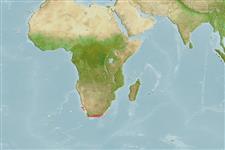Elasmobranchii (haaien en roggen) (sharks and rays) >
Carcharhiniformes (Ground sharks) >
Pentanchidae (Deepwater catsharks)
Etymology: Haploblepharus: haplos (Gr.), single or simple; blepharon (Gr.), eyelid, referring to simple structure of lower eyelid, which closes against upper eyelid to protect the eye. (See ETYFish); edwardsii: In honor of English naturalist George Edwards (1694-1773), known as the “father of British ornithology,” who was the first to illustrate this shark, in 1760. (See ETYFish).
Environment: milieu / climate zone / depth range / distribution range
Ecologie
marien demersaal; diepte 0 - 130 m (Ref. 5510), usually 40 - 130 m (Ref. 5510). Subtropical; 29°S - 35°S
Southeast Atlantic: Cape Agulhas to Natal in South Africa. There are two different forms of this species, the 'Cape' and 'Natal' types, which differ in coloration and habitat and might be geographic variants or two distinct species (Ref. 6782).
Lengte bij maturiteit / Grootte / Gewicht / Leeftijd
Maturity: Lm ?, range 41 - ? cm
Max length : 59.0 cm TL mannelijk / geslacht onbekend; (Ref. 244); 60.0 cm TL (female)
Korte beschrijving
Morfologie | Morfometrie
Dorsale stekels (totaal): 0; Dorsale zachte stralen (totaal): 0; Anale stekels 0; Anale zachte stralen: 0. Southeastern Cape form: sandy brown with 7 reddish-brown saddles bordered by black, and numerous small, dark brown and white spots between saddles; white below (Ref. 5578). Natal form: body cream in color with darker brown saddles and irregular white spots; white below (Ref. 5578).
Found in inshore and offshore waters of the continental shelf, on sandy and rocky bottoms (Ref. 244). Feeds on bony fishes, crustaceans and cephalopods (Ref. 244). Oviparous (Ref. 50449). Caught by surf anglers (Ref. 244).
Oviparous, with 1 egg-case laid per oviduct (Ref. 244). Embryos feed solely on yolk (Ref. 50449).
Compagno, L.J.V., 1984. FAO Species Catalogue. Vol. 4. Sharks of the world. An annotated and illustrated catalogue of shark species known to date. Part 2 - Carcharhiniformes. FAO Fish. Synop. 125(4/2):251-655. Rome: FAO. (Ref. 244)
Status op de Rode Lijst van het IUCN (Ref. 130435)
Gevaar voor de mens
Harmless
Gebruik door de mens
Visserij: visserij voor eigen gebruik; sportvis: ja
Meer informatie
Leeftijd/GrootteGroeiLengte-gewichtLengte-lengteLengtefrequentiesMorfometrieMorfologieLarvenLarvale populatiedynamiekRekruteringAbundantieBRUVS
ReferentiesAquacultuurAquacultuurprofielKweeklijnenGeneticaElectrophoresesErfelijkheidZiektesVerwerkingNutrientsMassaconversie
Tools
Speciale rapporten
Download XML
Internetbronnen
Estimates based on models
Preferred temperature (Ref.
123201): 12.8 - 20.5, mean 16.3 °C (based on 24 cells).
Fylogenetische diversiteitsindex (Ref.
82804): PD
50 = 0.5625 [Uniqueness, from 0.5 = low to 2.0 = high].
Bayesian length-weight: a=0.00355 (0.00176 - 0.00714), b=3.09 (2.91 - 3.27), in cm total length, based on LWR estimates for this (Sub)family-body shape (Ref.
93245).
Trofisch niveau (Ref.
69278): 3.8 ±0.3 se; based on diet studies.
Weerstandsvermogen (Ref.
120179): Zeer laag, minimale populatieverdubbelingstijd meer dan 14 jaar (Fec assumed to be <10).
Fishing Vulnerability (Ref.
59153): Moderate vulnerability (44 of 100).
Nutrients (Ref.
124155): Calcium = 29.5 [4.8, 158.9] mg/100g; Iron = 0.746 [0.202, 2.212] mg/100g; Protein = 18.4 [15.3, 21.4] %; Omega3 = 0.195 [0.086, 0.425] g/100g; Selenium = 20.3 [6.1, 57.3] μg/100g; VitaminA = 11.3 [4.0, 31.8] μg/100g; Zinc = 0.647 [0.307, 1.195] mg/100g (wet weight);
